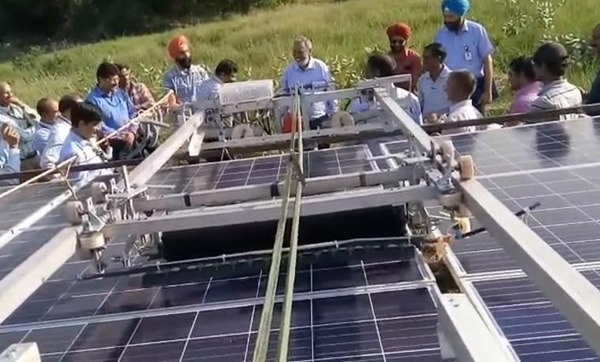This innovation is a cleaning apparatus for cleaning solar photovoltaic (PV) panels. The cleaning apparatus comprises a cleaning head unit comprising a cleaning head. The cleaning head unit is adapted to clean one or more contaminants from the surface of a solar PV panel. The cleaning apparatus further comprises a load application unit adapted to control the pressure applied by the cleaning head on the surface of the solar PV panel. The cleaning apparatus also has a driving unit operatively coupled to the cleaning head unit. The driving unit is adapted to drive the cleaning head unit along the surface of the solar PV panel with the applied pressure for cleaning the solar PV panel.
Solar photovoltaic (PV) panels lose efficiency over time due to the accumulation of dust, bird droppings, oily deposits, and other environmental contaminants on their surfaces. Manual cleaning is labor-intensive, inconsistent, and unsuitable for large installations, while existing automated solutions lack the ability to control cleaning pressure and adaptability based on surface conditions and contaminant types.
- Pressure-Controlled Cleaning Head: The innovation uses a load application unit with a pulley mechanism and adjustable load member to precisely control the pressure exerted by the cleaning head on the PV panel surface.
- Motorized Ball Screw Drive Mechanism: A second motor and ball screw system move the cleaning head linearly along the PV panel, ensuring uniform cleaning coverage.
- Rotational Cleaning Head: The cleaning head rotates at full speed via a first motor, made from lightweight plastic with a central steel rod for structural integrity.
- Water-Assisted Soaking Mechanism (Optional): It includes an inlet port to spray water for pre-soaking tough contaminants like dried bird droppings or toothpaste, enhancing cleaning effectiveness.
- Integrated Wiper System: It features a height-adjustable wiper that removes residual water and loosened debris after cleaning.
- Modular Test Bed Architecture: It has a fully realized tabletop prototype (Test Bed 200) with adjustable t-slot aluminum frame, linear guides, tilt angle adjusters, and comprehensive load-balancing system.
- Adaptability for Surface Contaminants: It has demonstrated cleaning effectiveness on various contaminant types (dry dust, dry/wet pastes, bird droppings) under both dry and wet conditions.
- Precision Load Management: It uses counterweights and pulley-controlled load adjustments to ensure consistent contact pressure between the cleaning head and panel.
The Test Bed 200 is a modular prototype designed to emulate the real-world cleaning of solar PV panels. It features a 10" x 10", 4 mm thick glass sheet to simulate the PV panel surface. A 5 cm diameter cleaning head, weighing 151 grams, is rotated by a motor operating at 500 RPM with 6 kg-cm torque to remove surface contaminants. The system employs a pulley-based mechanism with dense load members to control the downward cleaning pressure precisely. For linear movement of the cleaning head across the panel, a second motor (1000 RPM, 4 kg-cm torque) drives a ball screw assembly. Additionally, the setup incorporates a water inlet system for soaking tough debris and a wiper for effective post-cleaning residue removal. The entire assembly is mounted on a modular aluminum frame constructed from t-slot beams and linear guides, offering structural flexibility and adjustability. The prototype's cleaning effectiveness has been validated under various surface conditions and contaminant types.
A field prototype was manufactured and successfully demonstrated and tests were conducted. The device can be fitted on existing large-scale installations. It reduces water consumption up to 90 percent as compared to manual water-based cleaning.
6
The technology significantly improves solar panel efficiency by effectively removing surface contaminants and restoring optimal light transmission. By automating the traditionally labor-intensive cleaning process, it reduces reliance on manual labor, enhances safety, and ensures consistent performance. Its modular and scalable design allows for deployment across large solar farms, including installations in remote or hard-to-reach areas. Additionally, the system is water-efficient, using minimal amounts only when required, thereby conserving resources. Overall, the solution plays a critical role in supporting the growth of renewable energy by maintaining the performance and longevity of solar photovoltaic systems.
- Solar energy industry
- Renewable energy maintenance solutions
- Automated Robotic cleaning systems
- Smart grid and clean tech infrastructure
- Green building maintenance
- Industrial automation for PV farms
- Agrivoltaics and hybrid PV installations
Geography of IP
Type of IP
201811012285
538690

